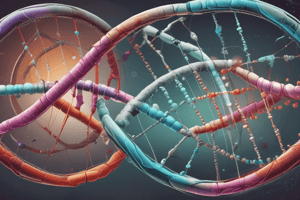Podcast
Questions and Answers
What is the approximate diameter of the DNA molecule according to the double helix model?
What is the approximate diameter of the DNA molecule according to the double helix model?
- 4 nanometers
- 2 nanometers (correct)
- 1 nanometer
- 5 nanometers
What are the two components of the sugar-phosphate backbone of the polynucleotide chain?
What are the two components of the sugar-phosphate backbone of the polynucleotide chain?
- Phosphate groups and nitrogenous bases
- Nitrogenous bases and phosphodiester bonds
- Sugar molecules and nitrogenous bases
- Sugar molecules and phosphate groups (correct)
What is the function of the phosphate groups in the sugar-phosphate backbone?
What is the function of the phosphate groups in the sugar-phosphate backbone?
- They facilitate the replication of DNA
- They act as a binding site for nitrogenous bases
- They give the backbone a negative charge (correct)
- They provide structural support to the backbone
What is the composition of a nucleotide?
What is the composition of a nucleotide?
According to the base pairing rules, which base pairs with Thymine (T)?
According to the base pairing rules, which base pairs with Thymine (T)?
What is the function of the phosphodiester bonds in the polynucleotide chain?
What is the function of the phosphodiester bonds in the polynucleotide chain?
What type of bond is formed between the 3' hydroxyl group of one nucleotide and the 5' phosphate group of another?
What type of bond is formed between the 3' hydroxyl group of one nucleotide and the 5' phosphate group of another?
What is the approximate pitch of the double helix structure?
What is the approximate pitch of the double helix structure?
What is the characteristic shape of the double helix model of DNA?
What is the characteristic shape of the double helix model of DNA?
Flashcards are hidden until you start studying
Study Notes
Polynucleotide Chain Structure
Double Helix Model
- The double helix model describes the 3D structure of DNA
- Two complementary polynucleotide chains twisted together
- Chiral, with a right-handed spiral staircase-like structure
- Diameter: approximately 2 nanometers (nm)
- Pitch: approximately 3.4 nm (10 base pairs)
Sugar-Phosphate Backbone
- The backbone of the polynucleotide chain is composed of:
- Sugar molecules (deoxyribose in DNA)
- Phosphate groups
- The sugar and phosphate molecules alternate in a repeating pattern
- The backbone is negatively charged due to the phosphate groups
Nucleotide Composition
- A nucleotide is composed of:
- A 5-carbon sugar (deoxyribose in DNA)
- A phosphate group
- A nitrogenous base (A, C, G, or T)
- Nucleotides are linked together through phosphodiester bonds
Base Pairing Rules
- Adenine (A) pairs with Thymine (T) through two hydrogen bonds
- Guanine (G) pairs with Cytosine (C) through three hydrogen bonds
- Base pairing is complementary, with each base having a specific partner
- Base pairing is responsible for the stability of the double helix structure
Phosphodiester Bonds
- Phosphodiester bonds link nucleotides together in a polynucleotide chain
- Formed through a condensation reaction between the 3' hydroxyl group of one nucleotide and the 5' phosphate group of another
- Phosphodiester bonds are strong covalent bonds that hold the backbone together
Studying That Suits You
Use AI to generate personalized quizzes and flashcards to suit your learning preferences.




